
About UsThe Numismatic Bibliomania Society is a non-profit organization promoting numismatic literature. For more information please see our web site at coinbooks.org SubscriptionsThose wishing to become new E-Sylum subscribers (or wishing to Unsubscribe) can go to the following web page link MembershipThere is a membership application available on the web site Membership Application To join, print the application and return it with your check to the address printed on the application. Membership is only $15 to addresses in the U.S., $20 for First Class mail, and $25 elsewhere. For those without web access, write to: David M. Sundman, Secretary/TreasurerNumismatic Bibliomania
Society AsylumFor Asylum mailing address changes and other membership questions, contact David at this email address: dsundman@LittletonCoin.com SubmissionsTo submit items for publication in The E-Sylum, just Reply to this message, or write to the Editor at this address: whomren@coinlibrary.com
BUY THE BOOK BEFORE THE COINYou won't regret it! |
- WAYNE'S WORDS: THE E-SYLUM JANUARY 4, 2009
- KOLBE JANUARY 10, 2009 NUMISMATIC BOOK AUCTIONS
- CHARLES DAVIS JANUARY 31, 2009 NUMISMATIC LITERATURE MAIL BID SALE
- DAVID SKLOW MAIL BID SALE #6 CLOSES FEBRUARY 7, 2009
- AN UPDATE FROM DAVID FANNING
- THE E-SYLUM COMPLETES 11TH VOLUME
- DICK JOHNSON BEGINS NEWEST STREAK OF CONSECUTIVE E-SYLUM POSTS
- JAMES MCNEES' COIN COLLECTORS DIGEST
- THE DECEMBER 2008 SPINK AUCTION INSIDER HIGHLIGHTS NUMISMATIC CIRCULAR
- ON THE METROPOLITAN NEW YORK NUMISMATIC CONVENTION
- ALAN DAVISSON ON NIALL FERGUSON'S NEW BOOK
- DICK JOHNSON ON ROBERT GRAHAM'S DESIGNS
- MORE ON AMERO BANKNOTES
- THE EURO'S TENTH ANNIVERSARY
- MORE ON THE CSA SILVER INGOTS
- BROOKLYN EAGLE ARTICLE EXAMINES HOLLOW SPY NICKEL CASE
- BOWERS SEEKS U.S. PAPER MONEY IMAGES FOR WHITMAN BOOK
- QUERY: INFORMATION ON BUFFALO NICKEL MODEL TWO MOON SOUGHT
- QUERY: JOSEPH CLOUD OF THE PHILADELPHIA MINT
- MARC MELLON DESIGNS OFFICIAL OBAMA PRESIDENTIAL INAUGURAL MEDAL
- JOHN LAW MEDALS A SIGN OF THE (MODERN) TIMES
- RUSSIAN BANKER RECOMMENDS DROPPING TWO SMALLEST COINS
- HOARD OF 7TH CENTURY GOLD COINS UNEARTHED IN ISRAEL
- QUOTE: A POX UPON YE WHO MANHANDLE BOOKS
- FEATURED WEB SITE: NATIONAL NUMISMATIC COLLECTION
WAYNE'S WORDS: THE E-SYLUM JANUARY 4, 2009
 As of last week we had 1,232 subscribers Bob Neale writes:
As of last week we had 1,232 subscribers Bob Neale writes: Well, among our recent subscribers are Jeff Melmed, Sam Brown and Wolfgang Bertsch. Welcome aboard! For a brief period we had the magic 1,234 subscribers. The number stands at 1,236 for the first issue of our 12th volume.
We open the new year with updates and information from four numismatic literature dealers: Kolbe, David, Sklow and Fanning. A lot of great material is coming up for sale early this year.
Articles on numismatic literature include topics such as the Coin Collectors Digest and Spink's Numismatic Circular. In topics first raised in earlier issues, we have more information on the Metropolitan New York Numismatic Convention, and sculptor Robert Graham.
Queries this week include questions about Joseph Cloud of the Philadelphia Mint and Two Moon, a model for Fraser's Indian Head (aka Buffalo) Nickel. To learn what that secret Russian spy message hidden in a Jefferson Nickel actually said, read on. Have a great week and Happy New Year, everyone.
Wayne Homren
Numismatic Bibliomania Society
KOLBE JANUARY 10, 2009 NUMISMATIC BOOK AUCTIONS

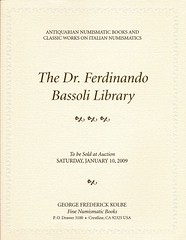
Please remember to send your bids for George Frederick Kolbe's Saturday, January 10th, 2009 New York City Auction featuring the Twinleaf Library of American numismatic rarities and the Dr. Ferdinando Bassoli Library of classic early-printed numismatic books and standard works on Italian numismatics.
Through Wednesday January 7th, Kolbe can be reached by telephone at (909) 338-6527; by email at GFK@numislit.com; or by fax at (909) 338-6980.
NO BIDS TRANSMITTED BY MAIL, EMAIL, FAX, OR BUSINESS TELEPHONE WILL BE ACCEPTED AFTER WEDNESDAY JANUARY 7TH.
Thursday, January 8th, will be a travel day.
Kolbe can be reached by telephone on Friday, January 9th, at (951) 236-1988, and on Saturday January 10th until 12: 30 PM. Telephone bidding may be available and several prominent numismatic literature dealers, who may be willing to accept commissions, plan to attend the sale.
CHARLES DAVIS JANUARY 31, 2009 NUMISMATIC LITERATURE MAIL BID SALE
Charlie Davis has planned a January 31st mail bid sale of "Numismatic Literature Surplus from the Library of the American Numismatic Society and Other Consignors". Highlights include:American Journal of Numismatics Volumes 1-25
Superb deluxe Beistle Early Half Dollars
Early Q. David Bowers Publications
Crosby Early Coins of America
Superb 1925 Browning Early Quarter Dollars
Elder Magazine complete
Superb set of Frossard’s Numisma
Husak Large Cent Catalogue; 3/100 deluxe edition
Mehl’s Monthly bound in by Alan Grace
First Notice (1950) of the “D” punched on 1804 $
Fine original Newlin on Half Dimes
Raymond 1935 Standard Catalogue leatherbound
Early American Cents - signed
Scott Coin Collector’s Journal complete
Long run of Red Books, signed and special editions
World’s Greatest Collection, Dr. Judd’s full calf ed
Demetrio Numismatique Egypte Ancienne
Mionnet complete in 16 volumes
Complete bound SNG Copenhagen
Blades List of Medals 1869
Blades Numismatica Typographica
Burns Coinage of Scotland, large paper
Lavoix Monnaies Musilmanes, 3 volumes
Here are a couple other lots from the sale that I thought I'd highlight as well.
From the sale catalog: Lot 68
Two photographs, the larger showing the mint as originally built in the 1830s and the smaller after its depression era reconstruction. Curiously Birdsall’s The United States Branch Mint at Charlotte does not contain a photograph of the original building.
Our old friend Joseph N. T. Levick was mentioned in the description of lot 90. From the sale catalog:
Davis 346. Elder's first house organ filled with news, original articles, and public lynching of his enemies, who in the early days were any collectors who did not pay their bills (names and addresses published) or who wrote letters displaying their ignorance of numismatics. On rare occasions there was praise.
In noting that J. N. T. Levick was known to be getting the “interesting little disks together in 1852,” Elder posed that “numismatics can hold a man in his later years. Mr. Levick can be found at every sale, minutely examining the pieces, making careful pencil notations, buying whenever anything suited his taste, and pricing his catalogue with the precision of clockwork. We doff our hats to J. N. T. Levick, the “youngest” coin collector in America.”
In general, dealer’s periodicals are considerably scarcer if not rarer than the auction sale catalogues each produced, and those of Thomas Elder are no exception. Initiated in March, 1906 as a monthly, Elder shifted to a bi-monthly format in June 1907 when several large consignments competed for his time. After changing the title to the Elder Magazine for the last two issues, he suspended publication entirely.
To view the sale catalog, see: www.vcoins.com/ancient/charlesdavis/store/catalog/mbs13109.pdf
DAVID SKLOW MAIL BID SALE #6 CLOSES FEBRUARY 7, 2009
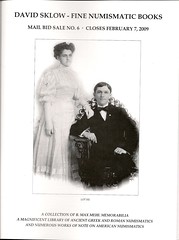 February 7, 2009, David Sklow-Fine Numismatic Books will close their 6th auction. Catalogs available by request; Send inquiries to: David Sklow-Fine Numismatic Books, P. O. Box 6321, Colorado Springs, CO 80934. Telephone: (719)-302-5686; Fax: (719)-302-4933; Email: numismaticbooks@aol.com.
February 7, 2009, David Sklow-Fine Numismatic Books will close their 6th auction. Catalogs available by request; Send inquiries to: David Sklow-Fine Numismatic Books, P. O. Box 6321, Colorado Springs, CO 80934. Telephone: (719)-302-5686; Fax: (719)-302-4933; Email: numismaticbooks@aol.com. The catalog is currently accessible on-line: www.finenumismaticbooks.com Bids will be accepted by, telephone, fax, email and regular mail. Several sale highlights:
A wonderful library of over 125 works on Ancient Roman and Greek Numismatics;
Du Choul, Guillaume. VETERUM ROMANORUM RELIGIO, CASTRAMETATIO, DISCIPLINA MILITARIS UT BALNEAE: EX ANTIQUIS NUMISMATIBUS & LAPIDIBUS DEMONFTRATA. Amsterdam, 1685;
Easton, E. {Publisher}. ANTIQUITATES SARISBURIENSES. London, 1771;
Hendriks, Frederick. DECIMAL COINAGE: A PLAN FOR ITS IMMEDIATE EXTENSION IN ENGLAND, IN CONNECTION WITH THE INTERNATIONAL COINAGE OF FRANCE AND OTHER COUNTRIES. Bucklersbury, England. 1866;
Breen, Walter and Gillio, Ronald J. CALIFORNIA PIONEER FRACTIONAL GOLD – “ADVANCE COPY”. Wolfeboro, N.H. 2003;
Edwards, Jonathan, M.D. CATALOGUE OF THE GREEK AND ROMAN COINS IN THE NUMISMATIC COLLECTION OF YALE COLLEGE. New Haven, 1880. iv-vi, 236pp. 8vo, original brown decorative cloth covers, gilt spine;
Memorabilia of the great numismatic dealer B. Max Mehl, including a long run of his auction catalogs, Mehl's Numismatic Monthly, advertising items of every description, Mehl family photographs, letters, Mehl's Coin Circular, Mehl's Coin Chronicle;
Very Rare "Sponsors Edition" of The National Bank note Issues of 1929-1935 copy #3 of 25;
A run of bound New Hampshire Bank reports;
Several bound historical works concerning the 1892-1893 Columbian Exposition;
Kroh, Dennis J. ANCIENT COIN REFERENCE REVIEWS. [SPECIAL HARDBOUND NUMBERED EDITION # 1of 20];
Morris, Robert. THE TWELVE CAESARS: (JULIUS TO DOMITIAN) ILLUSTRATED BY READINGS OF TWO HUNDRED AND SEVENTEEN OF THEIR – COINS AND MEDALS. La Grange, KY., 1877;
Mehl, B{enjamin} Max. 1907 WEDDING PHOTO OF B. MAX AND ETHEL.{Fort Worth, TX.}. 14.5 x 22 cm. black and white, professional portrait of B. Max seated, and his wife Ethel, standing at his side;
Raymond, Wayte and Macallister, J{ames}.G.{cataloguers}. THE NUMISMATIC AUCTION CATALOGUES OF J.C. MORGENTHAU & CO.New York, N.Y. 1932-1945. Adams Sale Numbers One through Fifty-three complete. The large format (4to) catalogues are bound uniformly in two quarto volumes; dark brown grained half cowhide, five raised spine bands, maroon calf spine labels, gilt, marbled paper boards: the small format (8vo) catalogues are housed in two quarto solander book boxes, matching identically the two other volumes; all original printed card covers are present; all quarto sales with original prices realized; many octavo sales with original prices realized and several handpriced;
Mickley, Jos. J. DATES OF UNITED STATES COINS AND THEIR DEGREES OF RARITY. Philadelphia, PA. 1858. 4pp. 8vo.;
Grueber, H{erbert}.A{ppold}., F.S.A. A FIND OF ANGLO-SAXON COINS. London, 1894, 48pp. 2 autotype plates, {also} THE BALCOMBE FIND. London, 1898, 65pp. 4 autotype plates, 8vo, half leather with marbled boards, four raised bands on spine, gilt spine;
Dye, John S. BANKING HOUSE OF JOHN S. DYE [DELINEATOR LETTER].New York. 1854, 8vo, 27 x 21cm;
Frossard, Ed{ouard}. NUMISMA. [DELUXE EDITION]. Minneapolis, MN. And Rocky River, OH. 1983 reprint of the 1877-1891 original, ten volumes complete. Special limited Edition copy # 4 of 4 produced. Half leather with marbled boards, gilt spine, marbled pastedowns and endpapers. A very special limited numbered edition of 4, of which this is number 4. Ex Kenneth Lowe Library sale by The Money Tree sale 32 lot 146;
United States Government. {Secretary of the Treasury}. LETTERFROM THE SECRETARY OF THE TREASURY TRANSMITTING SUNDRY STATEMENS REATIVE {SIC} TO THE OPERATIONS OF THE MINT OF THE UNITED STATES: FEBRUARY 28, 1817. READ AND ORDERED TO LIE UPON THE TABLE. Washington: 1817, 10pp. 1 foldout, folio 33.5 x 21cm;
and something for everyone!
Consignments are now being accepted for all future sales
AN UPDATE FROM DAVID FANNING
THE E-SYLUM COMPLETES 11TH VOLUME
John Nebel kindly compiled the following statistics on the first eleven volumes of The E-Sylum, which we completed with last week's issue. Since our first issue on September 4, 1998, we've published as total of 10,213 individual articles in 542 issues.| Volume | Year | #Issues | #Articles |
|---|---|---|---|
| 1 | 1998 | 12 | 55 |
| 2 | 1999 | 52 | 417 |
| 3 | 2000 | 54 | 559 |
| 4 | 2001 | 53 | 676 |
| 5 | 2002 | 52 | 706 |
| 6 | 2003 | 55 | 922 |
| 7 | 2004 | 52 | 1,107 |
| 8 | 2005 | 54 | 1,290 |
| 9 | 2006 | 53 | 1,540 |
| 10 | 2007 | 53 | 1,509 |
| 11 | 2008 | 52 | 1,432 |
| 542 | 10,213 |
I do have a life outside of these newsletters, though. A few months after beginning these missives our son Christopher was born - now he's 10 years old. Then came Tyler in 2000 and Hannah in 2004, followed by a move from Pittsburgh to Northern Virginia. This week brings a new addition to our family.
Not a kid this time, but a puppy - our first pet. Max is a two-month-old Yorkie-Poo we brought home yesterday. Our boys picked the name, but I stretched it to Maximilian and my wife made it Sir Maximilian. Big name for a small dog. Might as well be Max-A-Million for all the money we're spending on him.
Anyway, welcome, Max. Do any of our readers have horror stories (and/or advice) relating to dogs and numismatic libraries? -Editor
To access the E-Sylum back issue archive, see: www.coinbooks.org/club_nbs_esylum_archive.html
For a complete table of contents of all 10,213 articles, see: http://www.coinbooks.org/esylum_toc.html
DICK JOHNSON BEGINS NEWEST STREAK OF CONSECUTIVE E-SYLUM POSTS
As most regular readers are aware, one of our most prolific correspondents is Dick Johnson, who seems to have a submission in just about every issue. Good news and bad news about that - the bad news is that Dick's latest submission streak has ended. The good news is that he's started a new one with four submissions in the current issue.It's not Dick's fault - he makes an earnest effort each week and last week was no exception. But due to demands of the holiday and my overflowing inbox, I didn't get around to responding to his submission until just before press time late last Sunday.
Dick writes:
I'm not sure what went wrong in 2006, but this time I decided to pass on Dick's submission. Unfortunately, the hour was so late Dick didn't have time to rework or replace it. But he's back again with some great submissions, and I was able to work last week's item in, too. Sorry, Dick, and welcome back!
| FEATURED IN OUR JANUARY 10, 2009 NEW YORK PUBLIC AUCTION SALE S. H. CHAPMAN'S OWN SUPERB PLATED 1921 DR. J. M. HENDERSON SALE ONE OF ONLY A HALF DOZEN KNOWN GEORGE FREDERICK KOLBE Email: GFK@numislit.com Tel: (909) 338-6527 | 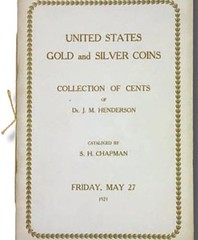 |
JAMES MCNEES' COIN COLLECTORS DIGEST
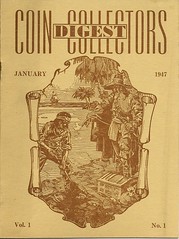 David Sklow's auction catalog #6 arrived this week. I flipped open the first two pages lasing the auction lots and my eye was drawn to lot 24. Coin Collectors Digest in bold face type caught my attention. That sounds interesting, somehow familiar. Then my eye moved up a line to the author, "James G. McNees" and a flood of memories filled my mind.
David Sklow's auction catalog #6 arrived this week. I flipped open the first two pages lasing the auction lots and my eye was drawn to lot 24. Coin Collectors Digest in bold face type caught my attention. That sounds interesting, somehow familiar. Then my eye moved up a line to the author, "James G. McNees" and a flood of memories filled my mind. That was printed on my old printing press! I had built a print shop starting in my junior year in high school. I had purchased a used 10 x 15-inch Chandler & Price printing press, and dozens of fonts of type and taught myself how to set type (by hand!), lock it in a press and how to run the press -- by foot power. The press was from the 1880s and old by then, but they never wear out.
I printed tickets for high school functions, a play program, and even membership cards for the Heart of America Numismatic Association. And stationery, lots of stationery for friends, family and even for an uncle who had two business in rural Missouri. It brought in enough money I could even buy a second, larger press.
The presses were set up in my grandparents' basement and I spent all my spare hours there printing small jobs that came my way. This went on for three years, even after my first year in junior college. (Here I found a way I could access the college bulletin board -- it was behind locked glass; I would print raunchy poems, jiggle the lock, lift the glass, and post them on the college bulletin board -- to the amusement of my college buddies)
My third college semester was at an out-of-town college, Baker University in Baldwin, Kansas [the Rev. Arthur B. Coole Oriental coin collection was located here]. And I had no time for printing. With the draft breathing down on me for the Army during the Korean War, I joined the Air Force (for 4 years) instead of being drafted into the Army (for 2 years). This was not for any patriotism, I liked the idea of flying.
I had to dispose of the print shop. I sold it to Jim McNees. He had four boys -- Jim was a photoengraver -- and he wanted to teach his boys graphic arts from the ground up. And that's why he bought my print shop and ultimately printed the Coin Collectors Digest now offered Dave's auction.

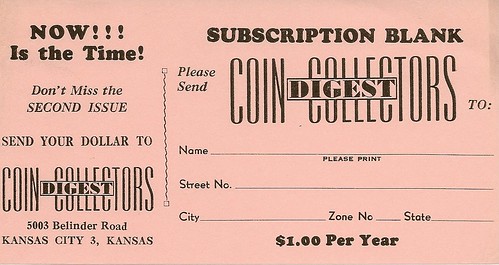
This went one for years. Homes, cars, every possession you could own were traded back and forth among the pair. Wives and children were the only things off limits. Ray was a successful salesman and Jim did well as a partner with his brother in the photoengraving business.
Jim once built a frame which he engraved at the top "Money of the World" and filled it with odd and curious money. He traded it to Ray. Somehow I got between the two and acquired it from Ray Janda before he traded it back to Jim. Forty years later I still have that frame with all that odd and curious money.
So, Dave, your lot 24 flooded me with hundreds of Jim McNees and numismatic memories. What a delight!
THE BOOK BAZARRE
THE DECEMBER 2008 SPINK AUCTION INSIDER HIGHLIGHTS NUMISMATIC CIRCULAR
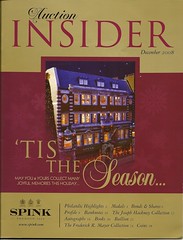 The December 2008 Auction Insider published by Spink includes a brief article on the history of the Numismatic Circular.
The December 2008 Auction Insider published by Spink includes a brief article on the history of the Numismatic Circular. First published in December 1892, the house organ has been produced continually with few major glitches, even through World War II, when the Spink office was hit by a bomb.
Only four distinguished editors have guided its publication over the last 116 years: Leonard Forrer, Howard Linecar, Douglas Saville, and now Philip Skingley.
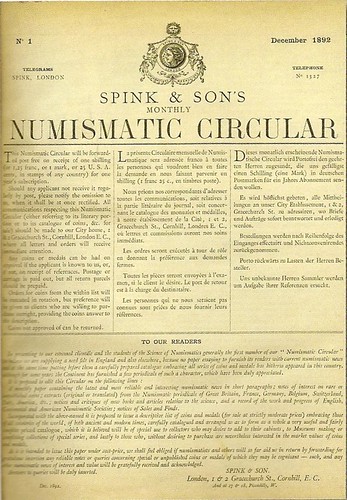
ON THE METROPOLITAN NEW YORK NUMISMATIC CONVENTION
George Cuhaj writes:
ALAN DAVISSON ON NIALL FERGUSON'S NEW BOOK
Alan Davisson writes: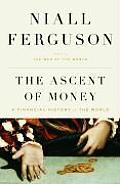 Thanks for the review of Niall Ferguson's new book. It is an interesting read, covering broad swaths of human enterprise. Interestingly enough, he got it wrong on the history of Roman coinage when he says that the aureus-denarius-sestertius coinage was minted with "all bearing the head of the reigning emperor on one side, and the legendary figures of Romulus and Remus on the other." He is mostly right on the first half of the assertion but wrong about the reverses.
Thanks for the review of Niall Ferguson's new book. It is an interesting read, covering broad swaths of human enterprise. Interestingly enough, he got it wrong on the history of Roman coinage when he says that the aureus-denarius-sestertius coinage was minted with "all bearing the head of the reigning emperor on one side, and the legendary figures of Romulus and Remus on the other." He is mostly right on the first half of the assertion but wrong about the reverses.He is not the only author who refers to coinage without checking his information. Some of Bernard Cornwell's series of historical fiction based on British history makes coinage-related mistakes as well.
I acknowledge that this may seem pretty picky on my part, but these simple misstatements leave a nagging concern in the back of my mind about information utilized in other parts of the work that might be equally questionable.
DICK JOHNSON ON ROBERT GRAHAM'S DESIGNS
The monument, called Gateway to the Olympic Stadium, was widely criticized at the time. It was said to be an atrocious monument displaying beheaded nude athletes, male and female, standing in a bucket of cement, on a giant slab supported by two pillars. It was more appropriate for disposal at sea rather than the entranceway for athletic achievement.
When this Gateway monument was chosen by the Treasury Department as the device for the dollar commemorative that year it submitted the design to the Commission of Fine Arts as required. The Commission members rejected the design calling it "a loser" but the Treasury, in its infinite wisdom, issued it anyway.
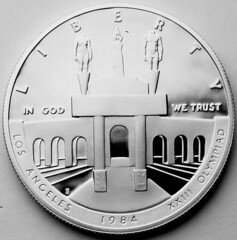
But that is not the last of it. For that same year Krause Publications awarded this coin a COTY -- Coin of the Year -- as the most popular coin. Evidence both of widespread lack of artistic acumen in the U.S. Treasury and the numismatic field. Bad Art Endures.
Incidentally in the index of names in Breen's Encyclopedia, following Graham's name is a cryptic "297b."
It didn't guide the reader to the entry of this coin (on page 606) and there is nothing about Graham on page 297. It was rumored Breen used this as a code word as a parting insult hurled at the artist. We mentioned this in E-Sylum (vol 3, no 8, art 7 as early as February 20, 2000). We asked if anyone could break the code. George Kolbe and Wayne Homren commented, but no one yet has broken the code for Breen's single arrow aimed at Graham.
To read the earlier E-Sylum article on Graham, see: SCULPTOR ROBERT GRAHAM 1938-2008 (http://www.coinbooks.org/esylum_v11n52a06.html)
MORE ON AMERO BANKNOTES
Beverly Lewis-Fifield writes:Normally, I would not have taken the rumors of changing our currency seriously, but when I saw them talking about it on the stock channel my ears perked right up. While Hal Turner could be all the things that he's accused of, I don't know because I've never listened to his show. The point is, the North American Union aka Security and Prosperity Partnership is very real.
There is a woman Senator from Ohio who has complained about this to Congress many, many times. By the way, I have also heard of another currency called the DEY, Dollar, Euro, Yen that is being considered.
NAFTA Super Highway - Congresswoman Kaptur explains on Congress Floor (http://uk.youtube.com/watch?v=cd29U90s_ik)
Congresswoman Marcy Kaptur on NAFTA and elites 4/6/08 (http://uk.youtube.com/watch?v=lmp2XHgXkvU)

To read last week's E-Sylum article on Amero notes, see: BLOGGER CLAIMS EVIDENCE OF NEW "AMERO" BANK NOTES (www.coinbooks.org/esylum_v11n52a16.html)
THE EURO'S TENTH ANNIVERSARY
With economic issues aside, how has the new currency effected the daily life of Europeans? Here are some of the recent factors:
- Euro coins are now circulated almost as widely as ancient Rome's denarius -- the first truly Pan-European coin.
- Half of French citizens still think in francs for every transaction in Euros.
- In several regional areas of Germany somewhat of a regional currency is in use -- shades of German State coinages of yore.
- Many countries are considering abolishing their lowest euro denomination coin or two because of entropy - they are just not viable in modern commerce. Much like other countries around the world which are abandoning their lowest coin, Europe's one-euro coins are destined to become extinct.
Still euro coins and paper money are serving well the purpose of a circulating medium for most of Europe. It is a compliment to the European Currency Union for their creation now with a decade of utility behind them.
"Currency unions come and go, typically revolving around one dominant power," states that same article. "The euro is a different animal. It has no political anchor. It is a leap into the unknown without a state, treasury, debt union, or EU social security net to back it up."
But economics dominates the discussion of any euro history, as does the long article below, which is chosen for its birthday celebration
To read the complete article, see: The euro's bitter-sweet triumph at 10 (http://www.telegraph.co.uk/finance/comment/ambroseevans_pritchard
/4045210/The-euros-bitter-sweet-triumph-at-10.html)
MORE ON THE CSA SILVER INGOTS
Regarding the silver"CSA" ingots discussed in earlier issues, Dave Bowers writes:Joe Boling writes:
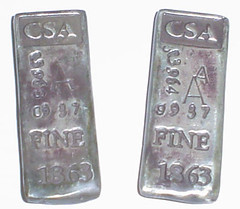
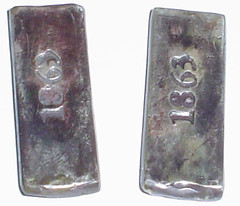
THE BOOK BAZARRE
BROOKLYN EAGLE ARTICLE EXAMINES HOLLOW SPY NICKEL CASE
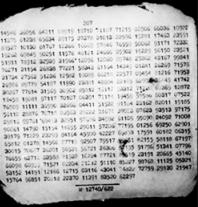 It was late June 1953 in Brownsville, another Monday night collecting Daily Eagle subscription fees door-to-door. Fourteen-year-old newsie Jimmy Bozart knocked on a door at 3403 Foster Avenue. His customer needed change for a buck so Jimmy got nickels from the housewives across the hall. The deal done, Bozart made his way out to the summer Brooklyn street.
It was late June 1953 in Brownsville, another Monday night collecting Daily Eagle subscription fees door-to-door. Fourteen-year-old newsie Jimmy Bozart knocked on a door at 3403 Foster Avenue. His customer needed change for a buck so Jimmy got nickels from the housewives across the hall. The deal done, Bozart made his way out to the summer Brooklyn street.As he bounded down the stairs, the nickels in Jimmy’s palm slipped from his grasp and fell to the floor. The newsie rushed to gather his change, and then he noticed one of the five-cent pieces had cracked on impact. Jimmy dropped the suspiciously light coin again to see what it was made of. As soon as the nickel hit the floor, Jefferson’s face split from Monticello on the other side.
“Whaddya know, there’s a picture inside this nickel.”
So began the strange saga of the hollow nickel case, a true spy story principally involving a nickel, a newsie, Brooklyn, Finland, Moscow, a sad spy, and a major motion picture starring Jimmy Stewart with special guest J. Edgar Hoover.
When Jimmy examined his busted nickel, he didn’t know what to make of the half-inch photograph inside it—a picture of nothing but numbers in columns. But as a newsvendor and an avid reader of the pulps, his gut told him it was a secret code, a spy thing. Bozart let his suspicions slip to a friend whose dad was a cop. The NYPD patrolman reported Jimmy’s nickel up the chain of command, and a few days later, the FBI came to collect that five-cent piece.
The Bureau couldn’t make heads or tails of the coin or the microfilm inside it. The nation’s best cryptologists and most sophisticated machinery could not crack the code. Agents fanned out to New York’s novelty shops, interrogated curiosity dealers and interviewed magicians. A nationwide effort to ferret out hollow coins yielded a few magic pennies in LA and DC—and in New York, a half-dollar novelty for the concealment of other, smaller coins. The Bureau’s search confirmed what Jimmy probably already knew: trick coins were common enough, but none of them looked like the Brownsville nickel. The hollow nickel case was left to cool in 1953, but it was not shelved.
To read the complete article, see: The Hollow Nickel Case: Espionage in the Borough of Brooklyn (http://www.brooklyneagle.com/categories/category.php?category_id=23&id=25448)
BOWERS SEEKS U.S. PAPER MONEY IMAGES FOR WHITMAN BOOK
I am now down to just a FEW notes for which I need color photos. Especially needed are the small-size.
The listing is divided into two categories: Small size notes and large size, the last including a lot of esoterica. Proofs are fine for some of the high denomination large-size issues. Indeed, circulating examples do not exist of some of them.
Thank you for ANYTHING you can supply!
SMALL SIZE NOTES
Regular Issues
$1 Federal Reserve Note, Series of 2006, Green Seal, current, any FR district.
$10 Gold Certificate, Series of 1928 Gold Seal. Not released. Might a specimen impression be available?
$10 Federal Reserve Note, Series of 1928-A, YELLOW-GREEN seal only.
$10 Federal Reserve Note, Series of 1981-A • F- 2028 any.
$10 Federal Reserve Note, Series of 2006, current, FORT WORTH
$500 Federal Reserve Note, Series of 1928, Light Yellow-Green Seal
$500 Federal Reserve Note, Series of 1934-C • F-2204 any bank
QUERY: INFORMATION ON BUFFALO NICKEL MODEL TWO MOON SOUGHT
Author Ginger Rapsus writes: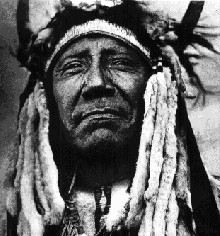 I have wrapped up novel #5, about the young lady who inherits a rare coin, takes it to a show, meets a nerd, who is actually a football player. Novel #6 is in the research stages...a fictionalized memoir of Two Moon, one of the models for the Buffalo nickel.
I have wrapped up novel #5, about the young lady who inherits a rare coin, takes it to a show, meets a nerd, who is actually a football player. Novel #6 is in the research stages...a fictionalized memoir of Two Moon, one of the models for the Buffalo nickel. Any suggestions for info on Two Moon, besides the familiar Buffalo Nickel volumes? Today I went to Borders downtown and found a reference book on the Cheyennes, which will help tremendously! Thanks.
QUERY: JOSEPH CLOUD OF THE PHILADELPHIA MINT
I'm continually impressed by what I learn of the skills and accomplishments of the gentlemen who manned the early Philadelphia Mint. From Director Rittenhouse on down, this was a very talented assemblage of individuals. Below is one reference to Cloud found on the Internet. Is anyone aware of other information on Joseph Cloud and his work at the Mint? -Editor
Death Notice At his residence in Delaware county, on the 31st ult., Joseph Cloud, Esq., aged 75 years. The deceased was appointed an officer in the U.S. Mint at Philadelphia, by General Washington, and held the situation till removed by Gen. Jackson. He was highly esteemed by all who knew him, and regarded as a man of fine scientific attainments.
Joseph CLOUD was "Refiner and Melter" of the United States Mint (Philadelphia) from 1797-1836. He was elected to America's oldest scholarly organization the American Philosophical Society (founded by Benjamin Franklin), in 1806. He served as Secretary (1812) and Curator (1814-22) under Thomas Jefferson who was President of the Society from 1797 to 1814. By training, Joseph Cloud was a chemist. Following are excerpts from Chemistry in Philadelphia, by Edgar F. Smith (1919), pp. 86-90: "He had an honorable share in finally establishing the individuality of palladium . . . Cloud's papers are thoughtful and give evidence of wide knowledge in chemistry and skill in experiment. . .
Joseph Cloud 1770 - 1845 (http://mykindred.com/cloud/TX/getperson.php?personID=I52734)
MARC MELLON DESIGNS OFFICIAL OBAMA PRESIDENTIAL INAUGURAL MEDAL
In an earlier issue I inquired about the status of the official Barack Obama Presidential Inaugural medal. At that time no decisions had been announced and the Inaugural Committee seemed to be completely incommunicado.Well, about 5pm today the committee published an email press release announcing the online opening of "the official Presidential Inaugural Store":
One of the items for sale is a bronze "medallion", priced at $60. Although there is an image of the medallion, there is no information on its size, finish or other important numismatic details. I suspected it's really a medal, not a large size medallion. Here's what the site says:
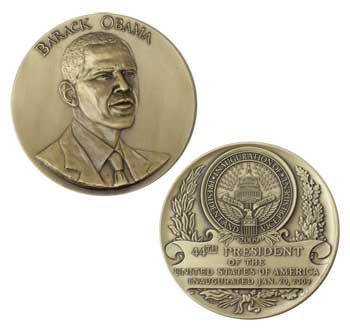
For more information on the Obama Inaugural medal, see: The 2009 Presidential Inaugural medallion (http://pic2009.inauguralcollectibles.com/optimizer/product/J0401.html)
What, no silver (or gold) versions? For more information I sought out the sculptor's web site. The diameter is 2.75 inches. Only the obverse was deisgned by Mellon - former U.S. Mint engraver Tom Rogers designed the reverse. The medals are being struck by the Medalcraft Mint of Green Bay, WI.
The series is widely collected, and considered to be an important part of the art history of America. Proceeds from the sale of the 2-3/4” medal will help make the inaugural events open to as many people as possible, as we commemorate the day Barack Obama takes office as the 44th President of the United States.
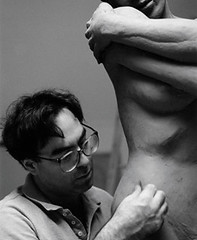
Schooled to pursue the sciences, Mellon left pre-medical studies for the study of history and philosophy before discovering art as a vehicle to embrace all of his interests. From the start he enjoyed the challenge of conveying something of the inner life of his subjects, multi-faceted portrait busts, dance and sports sculptures in balance and motion, and strong figures of women that project a modern female sensuality.
I was unaware of Marc Mellon before reading this announcement, but he has a very impressive body of work, including the 2003 Brookgreen Gardens medal. Be sure to check out his web site. Here's an image of him at work on the plaster model for the Obama obverse.
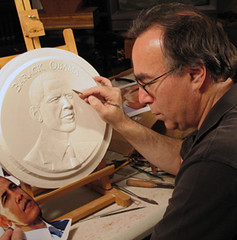
For more information on sculptor Marc Mellon, see: Marc Mellon Studio (http://www.mellonstudio.com/)
JOHN LAW MEDALS A SIGN OF THE (MODERN) TIMES
Cheapskate extraordinaire John Burns once scrawled this verse for me on a piece of paper:Times are hard
Here's your f*^#ing
Birthday card
Well, the events of 2008 have brought Hard Times upon many of us. But if it's any consolation, the world has seen tough economic times before and managed to endure. For one example, numismatists can looks to medals relating to John Law and the Mississippi Company, such as those cataloged as number 115 and 116 in C. Wylys Betts' 1894 work, American Colonial History Illustrated by Contemporary Medals.
Roughly translated, the inscriptions include the phrases "Credit Is As Dead As A Rat" and "Bankruptcy is the Fashion" Here's a description and image of one of the medals from Stack's.
From the Stack's January 2006 sale (John J. Ford, Part 13):
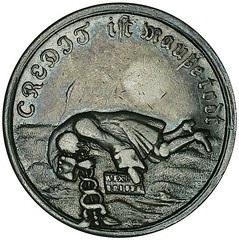

To view the complete lot description, see: Stack's January 2006 Auction, Lot 583 (http://www.stacksarchive.com/viewlot.php?auction=ST0106&lot=583)
To read the complete article, see: The Ponzi Paradigm (www.counterpunch.org/hudson12232008.html)
RUSSIAN BANKER RECOMMENDS DROPPING TWO SMALLEST COINS
Answer: Because we have to. We produce them because we have to in accordance with the legislation. We understand the point and our position is to abolish the smallest coins – at least 5 kopeks or 10 kopeks and smaller. But it’s up to the Parliament to adopt this or that decision, and of course we will fulfill it if they do. Question: By producing these coins you are losing money, aren't you?
Answer: We are losing. To read the lengthy interview click on the URL below (the coin questions are near the end): Russian Central Bank's policy (www.russiatoday.com/spotlight/release/1845/)
HOARD OF 7TH CENTURY GOLD COINS UNEARTHED IN ISRAEL
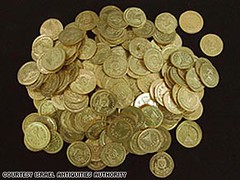 The Israel Antiquities Authority reported a thrilling find Sunday -- the discovery of 264 ancient gold coins in Jerusalem National Park.
The Israel Antiquities Authority reported a thrilling find Sunday -- the discovery of 264 ancient gold coins in Jerusalem National Park.The coins were minted during the early 7th century.
"This is one of the largest and most impressive coin hoards ever discovered in Jerusalem -- certainly the largest and most important of its period," said Doron Ben-Ami and Yana Tchekhanovets, who are directing the excavation on behalf of the Israel Antiquities Authority.
Researchers discovered the coins at the beginning of the eight-day Jewish holiday of Hanukkah, which started at sunset on Sunday.
To read the complete article, see: Israeli archaeologists find rare gold coins (www.cnn.com/2008/WORLD/meast/12/22/israel.rare.coins/)
QUOTE: A POX UPON YE WHO MANHANDLE BOOKS
 I do read more than just coin books, you know. I came across the following quote of interest to bibliophiles in Glut: Mastering Information Through the Ages by Alex Wright.
I do read more than just coin books, you know. I came across the following quote of interest to bibliophiles in Glut: Mastering Information Through the Ages by Alex Wright. It's an interesting account of how man stored and processed reams of information long before the age of the computer, a great way of providing some historical perspective. Technology may change, but people and their needs are constant.
I do what I do using a computer and Internet connection, and if Leonard Forrer were alive today he'd probably be producing the Numismatic Circular in front of a keyboard much like mine. -Editor
Writing of the world's first library, author Wright states:
FEATURED WEB SITE: NATIONAL NUMISMATIC COLLECTION
This week's Featured Web Site is recommended by John and Nancy Wilson. It's been featured before, but it's always well worth revisiting.
The NNC contains many great rarities in coins and currency, from the earliest coins created 2,700 years ago up to the latest innovations in electronic monetary exchange, as well as fascinating objects such as beads, wampum, dentalia, and other commodities once used as money.
The collection emphasizes the development of money and medals in the United States. The core of the U.S. collection, consisting of more than 18,000 items, including coins of great rarity, came to the Smithsonian in 1923 from the United States Mint.
http://americanhistory.si.edu/collections/numismatics/
